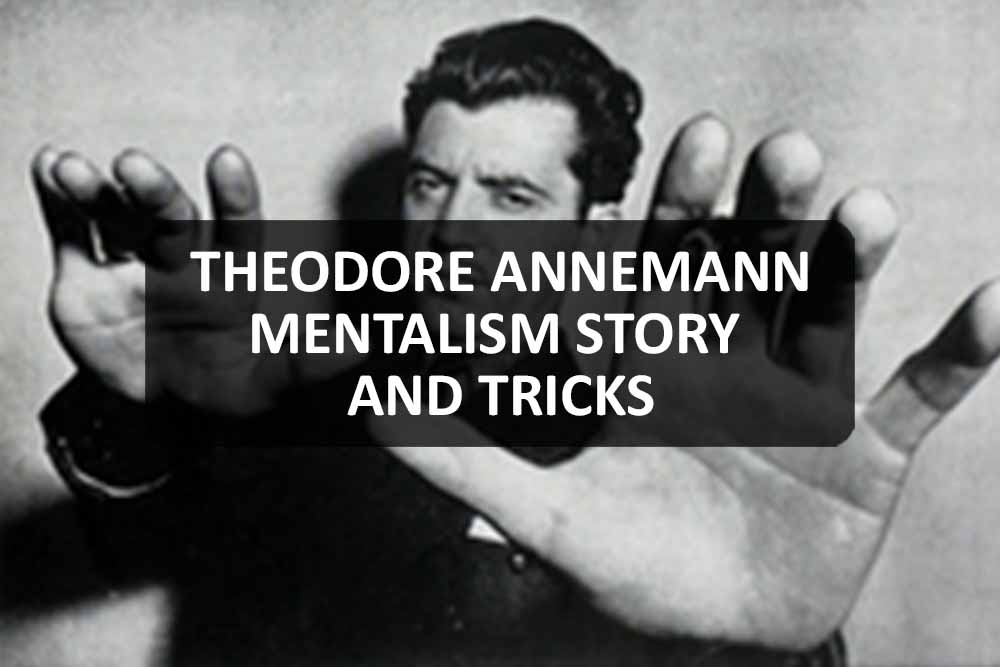One of the most prolific mentalists of his time, Theodore Anneman was also an exceptional writer and inventor. He created various practical and direct mentalism effects that many mentalists still use to this day.
Today, we’ll be talking about Theodore Anneman, his mentalism story and tricks, and the many great contributions he made to the world of mentalism in his very short-lived life.
A Little History of Theodore Annemann
Before he was Theodore Annemann, our great mentalist was born Theodore John Squires and lived in East Waverly, New York in 1907. When he was two, his father, Fred Squires left him and his mother, Flavilla, who remarried soon after to a Stanley Anneman.
Theodore took on his step-father’s last name and he then became Theo J. Anneman (he would later add the extra ‘n’ to his name in 1930).
From the age of 10, the young Theo found himself a fan of magic. Influenced by a friend who showed him the “Ball and Vase Trick” — he was mesmerized and immediately found himself buying his very own Ball and Vase. Later, he would show his newfound magic powers to anyone who would care to watch.
And so began his obsessive fascination with magic and mentalism.
Theodore Annemann’s Literary Influence
Annemann was an avid reader of magic literature. Whether it was books, manuscripts, or simple booklets, he would leaf through it all to improve his work. This was possibly what influenced him to write his own books.
By the young age of 17, Theo started contributing a few articles here and there to The Linking Ring and The Sphinx — his first contribution was titled “An Additional Effect of the X-Ray Eyes” by Theo J. Anneman.
While his works were largely based on old methods of magic and sleight of hand, his techniques were original and possessed his spin to them. His methods emphasized bold and subtle approaches, focusing rather on presentation than complex routines or sleight-of-hand.
Annemann was fully aware that it was the effect that counted above everything else.
<quote> “It is my theory that any effect to be successful must first be founded upon a simple method and then performed with a direct-to-the-point presentation…the moment one deviates from this straight line, he is not doing what a genuine magician or mind reader would do.”</quote>
Theodore became one of the revolutionary giants in the psychic and mind-reading fields, writing and publishing over a dozen books, plus thousands of articles.
A few of Annemann’s noteworthy manuscripts are:
- The Cabinet of Card Miracles (1929)
- Mental Mysteries (1929)
- The Book With a Name (1931)
- The Book Without a Name (1931)
- The Trick of the Month Club Presents: A Dead Name Duplication (1931)
- 202 Methods of Forcing (1933)
- Annemann Manuscripts (1933)
- Sh-h-h–!: It’s a Secret (1934)
- Annemann’s Complete One Man Mental And Psychic Routine (1935)
- Annemann’s Mental Bargain Effects (1935)
- En Rapport (1937)
- The Incorporated Strange Secrets (1939)
In 1934, Anneman began editing and publishing his magazine called ‘The Jinx’ — a publication that focused primarily on mentalism but also included some excellent magic effects. It ran for 151 episodes until it ceased publication in October 1941, shortly before Anneman’s sad passing.
Today, his book “Practical Mental Effects” has become one of the finest collections of mentalism tricks ever published, covering everything from Publicity Effects, Blindfold Readings, and Billet Switching, to Secret Coes and Book Tests.
Theodore Annemann’s Tricks and Contributions to Mentalism
Theodore was famous for having invented his own mentalism tricks, one being the Window Envelope. He was also quite well known for his version of the famous “Bullet Catch” — a notoriously precarious trick that had claimed the lives of numerous other magicians before him, including Chung Ling Soo.
Window Envelope Trick
To do this trick, you’ll need a pack of envelopes, a pair of scissors, some index cards, and a Sharpie.
After gathering your materials, what you want to do first is to take an envelope and seal the top. Once it’s sealed, take your scissors and make a small incision at the bottom of the envelope. Not too big that’s obvious to the audience, but not too small that your index card can’t fit.
Ask one of your audiences to write something (a word, a phrase, or a number) on one index card. Put it inside the envelope, and now you have a simple and quick mind-reading trick!
Just wiggle the index card out from the bottom where the incision is and read what your subject has written back to them!
Here’s a detailed video tutorial to help you out:
Note: Make sure the index card you use is exactly the same size as your envelope. You don’t want it getting stuck or sliding out during your trick.
The Bullet Catch
The Bullet Catch is one of the oldest and most famous illusions in the history of mentalism and magic. It’s also one of the most dangerous, so it’s not advisable for beginners to do it without proper instruction and assistance.
There is no one way of performing the Bullet Catch; some performers use blank bullets while others ask their assistance to fire and miss during the trick.
In Annemann’s version, he would collapse from the sheer force of the gun and then produce the bullet from his blood-drenched mouth.
Check out this video of Ted Annemann in action:
Theodore Annemann – The End of an Era
On January 12, 1942, Theodore Annemann was found dead in his home, an apparent suicide being the cause of his demise. This was two weeks before Annemann was scheduled to perform his famous Bullet Catch indoors for the first time.
No one knows the real reason why he chose to end his life that day.
Some accounts say he’d been struggling with personal demons during that time. Other accounts say he simply had too much of everything: alcohol, health problems, and constant fighting with his wife, Jeanette.
One thing’s for sure — he left the mentalism world far too soon.
But despite that, he also left a legacy to his name as one of the most prolific mentalists during that time.

